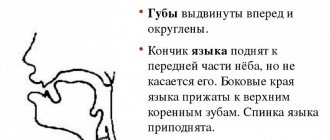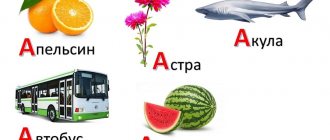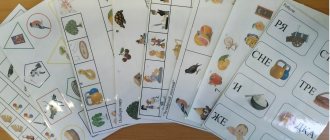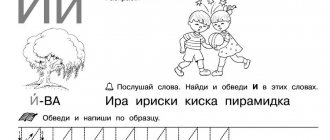We begin automating sounds in words only after the child clearly pronounces an isolated sound and can pronounce it correctly in syllables. We name words, highlighting the automated sound with our voice.
We pronounce the words slowly, pronouncing them clearly. It is advisable to repeat the same word 2-3 times.
Before you start automating the sound, you need to know the articulatory position of the sound P:
lips are open, neutral (it is better if they slightly expose the teeth);
teeth are open;
the lateral edges of the tongue are pressed against the upper molars;
the wide tip of the tongue is raised to the alveoli and vibrates.
Preparatory exercises for making the sounds R, Rb:
“Cup” “Drum” “Horses” “Mushroom”
"Accordion" "Machine gun"
Sound production:
The first method: by imitation with visual, auditory, kinesthetic control;
The second way: using special techniques:
- from a long 3-3-3 with the tip of the tongue raised to the alveoli,
- from a long J-J-J with lips stretched out in a smile,
-from rapid and repeated repetition of D-D-D.
NUTS FOR THE MIND. Game tasks for automating the sound Pb.
All-Russian distance competition of pedagogical skills for speech therapists and defectologists for the best development of visual didactic aids
Visual and didactic aid
"JACKETS FOR THE MIND"
Game tasks for automating the sound of Pb
Author of the manual: teacher-speech therapist Anna Anatolyevna Sergacheva
Relevance
Consolidating the pronunciation skills of a sound assigned by a speech therapist is a long and sometimes tedious process that requires the child to repeat multiple repetitions every day. Monotonous speech therapy exercises make the process of correcting pronunciation defects boring and therefore unproductive. In order for the play motivation that is natural for preschoolers and primary schoolchildren to give impetus to the formation of correctional motivation, children need interesting, emotionally rich tasks. This material turns the monotonous, routine work of strengthening the pronunciation of sounds into a fun, interesting activity for the child, and gives the speech therapist the opportunity to “playfully” carry out methodical speech therapy training.
The purpose of the speech therapy manual “Orrreshki for the mind”
: Pb sound automation.
Tasks:
consolidating the correct pronunciation of the sound Ръ in words in different positions, in phrases;
vocabulary enrichment;
development of grammatical structure of speech;
development of the psychological basis of speech: perception, attention, thinking, regulation of behavior due to submission to the rules of the game and the conditions of the tasks.
Age audience
: children 5-10 years old who have deficiencies in the pronunciation of the sound Рь.
Expected results
As a result of working with the manual “Orrrs for the Mind”, children will learn to correctly pronounce the automated sound in words in different positions, in phrases;
enrich your vocabulary;
learn to coordinate adjectives with nouns;
learn to construct sentences with given words.
Description of the manual and recommendations for its use
The book “Orrries for the Mind” contains entertaining game tasks that encourage the child to speak independently, rather than repeating after an adult, to communicate, and therefore contribute to faster automation of sound in spontaneous speech.
The manual consists of 13 cards.
The manual can be used both in individual lessons and in subgroup and group lessons.
You can build an entire lesson on the material of one card. The lexical material of the manual cards allows you to form the grammatical structure of speech, develop phonemic processes, and word formation skills. The following exercises help with this:
"greedy"
(word + possessive pronoun MY, MY, MY, MY)
No
whom? what?
a lot of
whom? what?
"crackers"
: speak and simultaneously clap words syllable by syllable
“call me affectionately”
check
items up to 5
Contents of tasks
Task 1 Pattern
Target:
automation of the sound Рь at the beginning of a word (Sheet 1), in the middle of a word (Sheet 2), in a combination of consonants (Sheet 3), at the end of a word (Sheet 4)
Instructions
for tables 1 and 2: Name the objects. Think about what rule they are repeated by and continue the series.
Instructions
for tables 3 and 4: What items are in the table? Name the items on the top line. What item should be in an empty cell? Name the items in the second line. What should be in an empty cell? Name the items on the bottom line. What subject is missing?
Sheet 1
Vocabulary: leggings, belt, backpack; reva, river; turnip, radish, radish; mignonette, burdock, rowan
Sheet 2
Vocabulary: pepper, cucumber; iris, birch, lilac; starling, hen, canary; dumplings, jam, crackers.
Sheet 3
Vocabulary: violin, rattle; paperclip, rattle, razor; oyster, shrimp, cod; hawk, swift, dragonfly.
Sheet 4.
Vocabulary: capercaillie, bullfinch; bubble, amber, door; librarian, mechanic, goalkeeper; shell, eel, gudgeon.
Task 2 Adventure game
Target:
automation of the sound Рь in the middle of a word.
Rules of the game
To play you need a dice and chips. Chips can be colored pebbles, large buttons, small toys from Kinder surprises, geometric figures cut out of colored cardboard.
To maintain children's speech activity, the number of players should be limited to 2-3.
Since the goal of every child is to get to the finish line as quickly as possible, the task of clearly pronouncing the sound Pb in words is perceived as a burden that slows down movement. In this case, the game loses its corrective speech therapy focus. The speech therapist should demand that the child move the chip only after correctly naming the picture. This requirement should become part of the rules of the game.
You can make a sentence with the word-name of the object on which the player’s piece has stopped; this object can be counted to five. Thus, the rules of the game will depend on the task set by the speech therapist.
Players take turns throwing the dice, moving the chips by the number of cells shown by the dice, clearly pronouncing the sound Pb in the words: “Nuts one, toffee two, jam three...”
Vocabulary: nuts, iris, jam, plate, mittens, root, foal, tangerine, village, cream, chicken, stool, exercise, birch, weights, rope, arena, tree.
Task 3 “Name it according to the diagram”
Target:
automation of the sound Рь in different positions in a word.
Instructions
First name the objects in the yellow shapes, then in the red ones, then in the blue ones and finally in the green ones.
First name the objects in round shapes, then in square ones, then in triangular ones and finally in polygonal ones.
First, look at the first group of small figures, find these figures and name the objects that are in them in order (bullfinch, lantern, root, belt). Now name the objects that are in the figures of the second group (hero, dumplings, hazel grouse, primer). And finally, name the objects in the figures of the third group (radish, burdock, charge, lizard).
Game "Hide and Seek"
Target:
determining the place of the sound Рь in a word.
Instructions
Determine where the sound Ръ is located in the word: at the beginning, in the middle, at the end. Hide the picture under the corresponding diagram.
Task 4 “Brown pencil”
Target:
automation of the sound Ръ in phrases; agreement of adjective with noun.
Instructions
Name the objects numbered 1. (Elastic band, bullfinch, mittens) Which of these objects can be brown? (Child: brown elastic band, brown mittens). Similarly with groups of objects numbered 2, 3, 4...
Vocabulary: 1. Elastic band, bullfinch, mittens. 2. chrysanthemums, belt, turnip. 3. Radish, rope, birch. 4. Beret, boar, radish. 5. Backpack, apricot, door. 6. Foal, bubble, stool. 7. Pepper, tangerine, spindle.
Task 5 “Extra item”
Target:
automation of the sound Рь in words and sentences.
Tasks
:
1. consolidating the correct pronunciation of the sound Рь in words in different positions, in phrases;
2. development of mental actions, the ability to make generalizations based on the essential features of objects;
3. consolidation of generalizing words;
4. enrichment of the subject vocabulary
5. developing the ability to construct a complex sentence with the conjunction because;
6. development of the ability to navigate on a sheet of paper.
Instructions
Speech therapist: Name the objects that are in the upper left rectangle, clearly pronounce the sound Ръ in words.
Child: grapefruit, apricot, tangerine, nuts.
Speech therapist: three subjects can be combined into a group, they are somewhat similar, but one subject does not fit, it is superfluous. Which item is missing?
Child: extra nuts, because grapefruit, apricot, tangerine are fruits, and nuts are not fruits.
Similarly, the child names objects and eliminates the extra object in the lower right, lower left, and upper right rectangles.
Vocabulary: bullfinch, starling, chicken, hazel grouse; grapefruit, apricot, tangerine, nuts; gudgeon, shrimp, vendace, cod; radishes, peppers, mushrooms, turnips.
Vocabulary: beret, leggings, trousers, mittens; sea, river, lake, shore; iris, mignonette, rowan, burdock; trapezoid, triangle, rectangle, circle.
Vocabulary: pan, plate, aquarium, ladle; violinist, animal trainer, conductor, guitarist; gingerbread, meatballs, crackers, croutons; armchair, dressing table, stool, stepladder.
Task 6 Analogies.
Target:
automation of the sound Рь in words and sentences.
Instructions
Look at and name all the pictures. Find objects that match each other and connect them with a line. What pair did you get? Make up a sentence with these words.
Possible pairs of words: tree-root, birdhouse-starling, cherry-jam, turtle-shell, sailor-frigate, pepper-bed, knight-fortress.
Task 7 Rebuses
Target:
automation of the sound Рь in words and sentences.
Instructions
Read the syllables. Add the name of the picture to each syllable. What words did you come up with? Make a sentence with each word.
Encrypted words: vendace, dragonfly, bullfinches, rattle, iris, exercise, foal, primer.
Task 8 Adventure game “Professions”
Target:
automation of the sound Рь in words and sentences.
Rules of the game
To play you need a dice and chips. To maintain children's speech activity, the number of players should be limited to 2-3.
Players take turns throwing the dice, moving the chips by the number of squares shown by the dice, clearly pronouncing the sound Pb in the words: “Courier one, guitarist two, make-up artist three...”. The player explains what the representative of the profession in which the chip has settled on does. If the child cannot do this, a second player can help him. In this case, the second player gets the opportunity to move his piece one square forward.
Informational resources
Zhikhareva Yu. B. Home notebook for speech therapy classes with children. Issue 4. Sound Рь. – M.: Publishing house VLADOS, 2021
Komarova L. A. Automation of the sound Pb in game exercises. – M.: GNOM Publishing House, 2021.
Pictures from the Internet.








